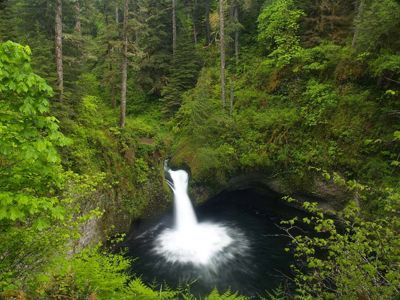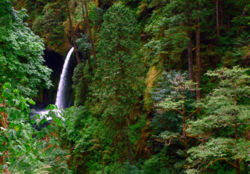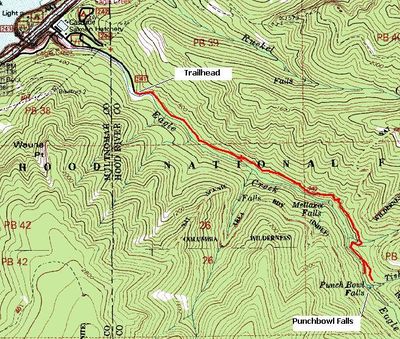Difference between revisions of "Eagle Creek to Punch Bowl Falls Hike"
From Oregon Hikers Field Guide
(change rating) |
|||
| (One intermediate revision by one user not shown) | |||
| Line 45: | Line 45: | ||
Maybe as impressive as the trail itself is the story of how it was built. It was begun in 1915 as part of the work on the Historic Columbia River Highway. In many sections, workers used dynamite to blast the trail out of cliff faces. The Forest Service's first full-service campground was established where the fish hatchery now is, and soon thousands of people could enjoy areas that were impossible to traverse otherwise. The original trail has remained nearly unchanged to this day. | Maybe as impressive as the trail itself is the story of how it was built. It was begun in 1915 as part of the work on the Historic Columbia River Highway. In many sections, workers used dynamite to blast the trail out of cliff faces. The Forest Service's first full-service campground was established where the fish hatchery now is, and soon thousands of people could enjoy areas that were impossible to traverse otherwise. The original trail has remained nearly unchanged to this day. | ||
| − | Starting at the trailhead, pass a weir, and then follow the wide well-groomed trail above the creek for a stretch. The steep slopes above you are composed of conglomerates from the Eagle Creek Formation, sedimentary deposits laid down by the ancient Columbia River millions of years before the Columbia River Basalt Flows. In fact, you'll soon pass a large fossil tree stump, now much diminished because of the depredations of decades of souvenir snatchers. Also, you'll notice blackened conifers from the 2017 fire almost immediately, and most of the maples went up in flames but are vigorously sprouting back from their lignotubers. | + | Starting at the trailhead, pass a weir, and then follow the wide well-groomed trail above the creek for a stretch. The steep slopes above you are composed of conglomerates from the Eagle Creek Formation, sedimentary deposits laid down by the ancient Columbia River millions of years before the Columbia River Basalt Flows. In fact, you'll soon pass a large fossil tree stump, now much diminished because of the depredations of decades of souvenir snatchers. Also, you'll notice blackened conifers from the 2017 fire almost immediately, and most of the maples went up in flames but are vigorously sprouting back from their lignotubers. After you pass into a dripping grotto festooned with maidenhair fern, you'll rise above the Eagle Creek Formation and reach cliffs of Columbia River Basalts where the trail was blasted out of the rock. Here there is the first set of handrail cables, one of several along the trail. Penstemon, arnica, and saxifrage cling to the rocky fastness. Looking across the gorge, you can see different layers of basalt entablature separated by narrower bands of colonnade. Many months, the fog hangs low in the canyon, blocking your view of the sheer basalt walls towering above you. In places the trail is narrow, and you need to take care when passing others. |
Soon you'll reach your second cliff face, also with a cable handrail. The small oaks on this steep slope were burned but are coming back from their bases. Conifers at the bottom of the canyon survived the fire with a full canopy, but you'll pass through a scorched area where fireweed, thimbleberry, poison oak, and ocean spray flourish. After you walk between two large Douglas-firs, you will see up the narrow gorge to the lower horsetail of 100-foot [[Sorenson Falls]] splashing off the east rim. Then 82-foot [[Metlako Falls]] spouts on Eagle Creek itself, where it makes a tight turn east. This will be your best sighting of [[Metlako Falls]] as the former overlook, on a now abandoned spur trail off the trail ahead, disappeared in a landslide in December 2016. As you turn into a gully, you'll get a glimpse of the top of [[Metlako Falls]] across the gorge and then cross [[Sorenson Creek Crossing|Sorenson Creek]], with its round concrete steps. | Soon you'll reach your second cliff face, also with a cable handrail. The small oaks on this steep slope were burned but are coming back from their bases. Conifers at the bottom of the canyon survived the fire with a full canopy, but you'll pass through a scorched area where fireweed, thimbleberry, poison oak, and ocean spray flourish. After you walk between two large Douglas-firs, you will see up the narrow gorge to the lower horsetail of 100-foot [[Sorenson Falls]] splashing off the east rim. Then 82-foot [[Metlako Falls]] spouts on Eagle Creek itself, where it makes a tight turn east. This will be your best sighting of [[Metlako Falls]] as the former overlook, on a now abandoned spur trail off the trail ahead, disappeared in a landslide in December 2016. As you turn into a gully, you'll get a glimpse of the top of [[Metlako Falls]] across the gorge and then cross [[Sorenson Creek Crossing|Sorenson Creek]], with its round concrete steps. | ||
Revision as of 23:00, 1 August 2021
- Start point: Eagle Creek Trailhead
- End point: Punch Bowl Falls
- Hike Type: Out and back
- Distance: 4.2 miles (round trip)
- Elevation gain: 525 feet
- High point: 505 feet
- Difficulty: Easy
- Seasons: Year round
- Backpackable: No
- Family Friendly: Yes, for older kids
- Crowded: Yes
|
|
Contents |
**Falling Hazard**
Be careful with dogs or small children on the Eagle Creek Trail. There is a steep cliff to one side of the trail in several sections. Dogs must be on a leash at all times.
Hike Description
The Eagle Creek to Punch Bowl Falls hike is one of the shorter options for taking in the beauty of the Columbia River Gorge and perhaps is the most popular, taking in three of the 10 major waterfalls to be seen along the creek and its tributaries. Note that the name of the waterfall is correctly spelled as two words, i.e. "Punch Bowl" not "Punchbowl."
The Eagle Creek Trail is the quintessential hike in the Columbia River Gorge, boasting several spectacular waterfalls, tall basalt cliffs, and the lush temperate rain forests that so characterize the Pacific Northwest. The 2017 Eagle Creek Fire has scarred the landscape, however, although the trail, reopened in 2021 after much painstaking labor by the PCTA (Pacific Crest Trail Association), is fully intact. That lush forest canopy has completely burned off in places, and an understory of sun-loving shrubbery has grown up along much of the lower section of the trail. The blackened snags and scorched trunks of conifers stand out on the steep hillsides above the Eagle Creek gorge.
Maybe as impressive as the trail itself is the story of how it was built. It was begun in 1915 as part of the work on the Historic Columbia River Highway. In many sections, workers used dynamite to blast the trail out of cliff faces. The Forest Service's first full-service campground was established where the fish hatchery now is, and soon thousands of people could enjoy areas that were impossible to traverse otherwise. The original trail has remained nearly unchanged to this day.
Starting at the trailhead, pass a weir, and then follow the wide well-groomed trail above the creek for a stretch. The steep slopes above you are composed of conglomerates from the Eagle Creek Formation, sedimentary deposits laid down by the ancient Columbia River millions of years before the Columbia River Basalt Flows. In fact, you'll soon pass a large fossil tree stump, now much diminished because of the depredations of decades of souvenir snatchers. Also, you'll notice blackened conifers from the 2017 fire almost immediately, and most of the maples went up in flames but are vigorously sprouting back from their lignotubers. After you pass into a dripping grotto festooned with maidenhair fern, you'll rise above the Eagle Creek Formation and reach cliffs of Columbia River Basalts where the trail was blasted out of the rock. Here there is the first set of handrail cables, one of several along the trail. Penstemon, arnica, and saxifrage cling to the rocky fastness. Looking across the gorge, you can see different layers of basalt entablature separated by narrower bands of colonnade. Many months, the fog hangs low in the canyon, blocking your view of the sheer basalt walls towering above you. In places the trail is narrow, and you need to take care when passing others.
Soon you'll reach your second cliff face, also with a cable handrail. The small oaks on this steep slope were burned but are coming back from their bases. Conifers at the bottom of the canyon survived the fire with a full canopy, but you'll pass through a scorched area where fireweed, thimbleberry, poison oak, and ocean spray flourish. After you walk between two large Douglas-firs, you will see up the narrow gorge to the lower horsetail of 100-foot Sorenson Falls splashing off the east rim. Then 82-foot Metlako Falls spouts on Eagle Creek itself, where it makes a tight turn east. This will be your best sighting of Metlako Falls as the former overlook, on a now abandoned spur trail off the trail ahead, disappeared in a landslide in December 2016. As you turn into a gully, you'll get a glimpse of the top of Metlako Falls across the gorge and then cross Sorenson Creek, with its round concrete steps.
At the junction with the Lower Punch Bowl Trail #440B, you can go right to switchback down into the gorge, getting views below of little Lower Punch Bowl Falls above a logjam. The spur trail takes you down about 300 feet in a quarter of a mile. When you get to the creek, you'll notice a massive amount of debris across the water and a fresh scar on the cliffs opposite. This landslide occurred near the beginning of 2018 and initially blocked the creek. While hikers used to be able to work their way up the wide open, cobbled shoreline to a view of Punch Bowl Falls about a hundred yards upstream, this is now a rocky scramble. In the summer months, the shore at Lower Punch Bowl Falls can be a crowded area, but given the right weekday in the off-season, this is an enchanted, quaint setting as you contemplate the forces of nature.
Back up at the main Eagle Creek Trail, turn right and cross a massive crib wall constructed by the PCTA at a spot where the trail slid away. Soon, you'll come to the Punch Bowl Falls overlook, where you can view Punch Bowl Falls spouting into its circular amphitheater and magnificent deep pool below. You may recognize this viewpoint from photos and postcards. Please stay inside the guardrails. Every year, there is a story about someone falling from this spot and injuring themselves.
See these other hikes that give you longer alternatives; otherwise return to your vehicle:
Maps
- Maps: Hike Finder
- Green Trails Maps: Bonneville Dam, OR #429
- Green Trails Maps: Columbia River Gorge - West #428S
- Geo-Graphics: Trails of the Columbia Gorge
- U.S. Department of Agriculture, Forest Service/Bureau of Land Management: Columbia River Gorge
- National Geographic Trails Illustrated Map: Columbia River Gorge National Scenic Area
Regulations, fees, etc
- Northwest Forest Pass (or America the Beautiful Pass) required; fee kiosk at the trailhead
- Restrooms, picnic tables, information kiosk, nearby campground
- Dogs on leash
- Limited parking; if lot is full, go back to the Eagle Creek Day Use Trailhead
Trip Reports
- Search Trip Reports for Eagle Creek Punch Bowl Falls
Related Discussions / Q&A
- Search Trail Q&A for Eagle Creek Punch Bowl Falls
Guidebooks that cover this hike
- I Heart Oregon (& Washington) by Lisa D. Holmes
- Afoot & Afield: Portland/Vancouver by Douglas Lorain
- 100 Hikes in Northwest Oregon & Southwest Washington by William L. Sullivan
- Trips & Trails: Oregon by William L. Sullivan
- Take a Hike: Portland by Barbara I. Bond
- Hiking Oregon’s Geology by Ellen Morris Bishop
- PDX Hiking 365 by Matt Reeder
- Curious Gorge by Scott Cook
- Pokin’ Round the Gorge by Scott Cook
- Day Hiking: Columbia River Gorge by Craig Romano
- Day Hikes in the Columbia Gorge by Don J. Scarmuzzi
- 60 Hikes Within 60 Miles: Portland by Paul Gerald
- Best Hikes Near Portland, Oregon by Fred Barstad
- Day Hike! Columbia Gorge by Seabury Blair, Jr.
- Oregon: The Creaky Knees Guide by Seabury Blair, Jr.
- Portland Hikes by Art Bernstein & Andrew Jackman
- Columbia Gorge Getaways by Laura O. Foster
- Hiking the Columbia River Gorge by Russ Schneider; revised by Jim Yuskavich
- Best Short Hikes in Northwest Oregon by Rhonda & George Ostertag
- Oregon Hiking by Sean Patrick Hill
- Pacific Northwest Hiking by Scott Leonard & Sean Patrick Hill
- Hiking Waterfalls in Oregon by Adam Sawyer
- Best Outdoor Adventures Near Portland, Oregon by Adam Sawyer
- Hiking Oregon by Lizann Dunegan
- Hike America: Oregon by Lizann Dunegan
- 50 Hikes in Oregon by David L. Anderson
- Oregon’s Wilderness Areas by George Wuerthner
- 100 Oregon Hiking Trails by Don & Roberta Lowe
- Short Trips & Trails: The Columbia Gorge by Oral Bullard & Don Lowe
- 70 Virtual Hikes of the Columbia River Gorge by Northwest Hiker
- Oregon’s Best Wildflower Hikes: Northwest Region by George Wuerthner
- Oregon’s Columbia River Gorge: Camping & Hiking by Tom Steinstra & Sean Patrick Hill
- Best Dog Hikes: Oregon by Adam Sawyer
- Canine Oregon by Lizann Dunegan
- Fire, Faults, and Floods: A Road & Trail Guide Exploring the Origins of the Columbia River Basin by Marge & Ted Mueller
- Waterfall Lover’s Guide: Pacific Northwest by Gregory A. Plumb
- Waterfalls of the Pacific Northwest by David L. Anderson
More Links
- Eagle Creek Trailhead & Trail (#440) (USFS)
- Lower Punch Bowl Trail (#440B) (USFS)
- Eagle Creek to Punchbowl Falls (Friends of the Columbia Gorge)
- Eagle Creek to Punchbowl Falls (Oregon Wild)
- Metlako Falls and Punchbowl Falls Hike (Northwest Hiker)
- Punchbowl Falls (ProTrails)
- Cliff Collapse at Punch Bowl Falls! (WyEast Blog)
- Sorenson Falls (Northwest Waterfall Survey)
- Metlako Falls (Northwest Waterfall Survey)
- Metlako Landslide! (WyEast Blog)
- Lower Punch Bowl Falls (Northwest Waterfall Survey)
- Punch Bowl Falls (Northwest Waterfall Survey)
- Punch Bowl Falls (World of Waterfalls)
- Eagle Creek (OregonWildflowers.org)
- "Now 100 years old, Eagle Creek helped revolutionize camping in the 20th century" (Oregon Live)
- Eagle Creek History (Splintercat)
- Eagle Creek Fire (Wikipedia)










